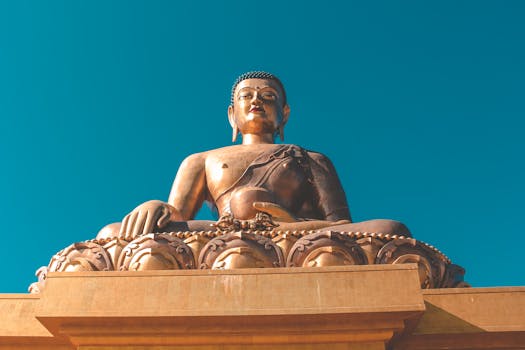Journey to Bhutan: The Last Shangri-La
Bhutan, a hidden gem nestled in the heart of the Himalayas, is often referred to as the last Shangri-La. This title, borrowed from James Hilton's novel 'Lost Horizon', is not bestowed lightly. It signifies a place of eternal happiness and tranquility, untouched by the ravages of time and modernity. In Bhutan, this is more than just a metaphorical description; it's a tangible reality that greets you at every turn.

The journey to Bhutan is an immersion into an enchanting world where ancient culture and untouched landscapes coexist in perfect harmony. The country's unique blend of spiritual tranquility and breathtaking natural beauty offers a captivating escape from the modern world. As you delve deeper into its heart, you encounter a realm where time-honored traditions meet awe-inspiring vistas, creating an atmosphere of serenity and simplicity that seems almost otherworldly.
One cannot talk about Bhutan without mentioning its majestic monasteries. Perched on cliffs with panoramic views of the valleys below, these monasteries are not just places of worship but also repositories of Bhutanese culture and history. They stand as silent witnesses to centuries of spiritual devotion, their walls echoing with chants that have been passed down through generations.
Equally captivating are Bhutan's vibrant festivals. These events are not mere celebrations but living narratives of folklore and tradition. They offer a glimpse into the country's rich cultural tapestry, marked by colorful masks, intricate dances, and soulful music that reverberates through the mountain air.
But what truly sets Bhutan apart is its commitment to preserving its natural environment. The country is one of the few places in the world where environmental conservation is not just a policy but a way of life. This ethos is reflected in its pristine forests, crystal-clear rivers, and diverse wildlife – all testament to Bhutan's respect for Mother Nature.
So why does Bhutan epitomize the last Shangri-La? The answer lies in its ability to maintain a delicate balance between preserving its cultural heritage and embracing the necessities of modern life. Despite the encroachment of globalization, Bhutan has managed to retain its unique identity, offering a refreshing contrast to the homogenized landscapes that dominate much of the world today.
The journey to Bhutan is more than just a physical voyage; it's an exploration of a way of life that values happiness over material wealth, spirituality over dogma, and nature over exploitation. It's an opportunity to step back into a forgotten era where life moves at a slower pace, and every moment is savored for its inherent beauty.
Bhutan's allure lies not just in its scenic landscapes or ancient traditions but in its people. Their warmth, hospitality, and genuine happiness are infectious, making every interaction a memorable experience. This sense of contentment stems from their deep-rooted belief in 'Gross National Happiness', a philosophy that prioritizes collective well-being over economic growth.
As you leave Bhutan, you carry with you more than just memories of majestic mountains and vibrant festivals. You take away lessons on simplicity, contentment, and respect for nature – values that are increasingly rare in our fast-paced world. This is the magic of Bhutan, the last Shangri-La – a place that not only captivates your senses but also touches your soul.
The journey to Bhutan offers a profound understanding of what it means to live in harmony with nature and tradition. It's an experience that challenges our conventional notions of progress and success, prompting us to question whether true happiness lies in material wealth or in the simple joys of life. As we navigate through our complex world, perhaps we can all learn something from this last Shangri-La – about preserving our cultural heritage, respecting our environment, and most importantly, about finding joy in simplicity.
How to get there
Embarking on a journey to Bhutan involves distinct steps due to its cautious tourism and conservation policies. Most travelers arrive by air at Paro International Airport, which is well serviced by Druk Air and Bhutan Airlines. From the hub cities of Bangkok, Kolkata, Delhi, Kathmandu, Dhaka, and Singapore, these airlines ferry visitors into the heart of Bhutan's sweeping landscapes. Land entry is also possible through the border towns of Phuentsholing, Gelephu, and Samdrup Jongkhar which connect Bhutan with the Indian mainland.
Key places to visit
Bhutan's allure is encapsulated in its majestic fortresses (Dzongs), serene monasteries, and vibrant cultural centers. The iconic Tiger's Nest Monastery (Paro Taktsang), precariously perched on a cliff face, is perhaps the most photographed site and offers an unrivaled spiritual hike experience. The Punakha Dzong, residing at the confluence of two rivers, serves as a stunning representation of Bhutanese architecture and history. For those keen on exploring urban culture, Thimphu—the capital city—provides a mix of traditional and modern with landmarks such as the Buddha Dordenma Statue and the bustling weekend market. Nature enthusiasts must not miss the Phobjikha Valley; renowned for its scenic vistas and black-necked crane migration.
Websites to check out:
- tourism.gov.bt - Official tourism portal of Bhutan offering comprehensive travel guidelines & festival dates.
- drukair.com.bt - Essential for checking flight options into Bhutan’s Paro International Airport.
- bhutanairlines.bt - Offers detailed flight schedules & bookings to help plan your trip to Bhutan.
- lonelyplanet.com/bhutan - In-depth travel advice, itineraries & logistical tips on Bhutan.